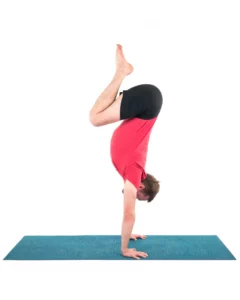Can Yoga Help Quell Age-Related Weight Gain?

Article At A Glance
Do you dread stepping on the scale at your annual physical? Unwanted pounds seem to accumulate as we move into our 50s and 60s. Despite exercising and eating a healthy diet, older bodies don’t respond to weight loss efforts as easily as they did in our 30s. Yoga may not be a panacea for age-related weight gain, but it can be a valuable tool in the middle-age “battle of the bulge.”
Dread stepping on the scale at your annual physical? Cringe when looking at the photos of yourself from your niece’s wedding? Unwanted pounds seem to accumulate as we move into our 50s and 60s. Despite exercising and eating a healthy diet, older bodies don’t respond to our weight loss efforts as easily as they did in our 30s. While yoga is not a band-aid for age-related weight gain, it is a valuable tool in the middle-age “battle of the bulge.”
Aging, Digestive Health, and Age-Related Weight Gain
First, it’s useful to acknowledge that weight gain is a natural part of the aging process. In fact, statistics show that on average, U.S. adults tend to gain one to two pounds per year as they age.
The problem lies, therefore, in that incremental weight gain can result in significant weight changes and even obesity. Obesity increases an individual’s risk for other medical problems, such as type 2 diabetes, hypertension, cardiovascular disease, sleep apnea and osteoarthritis.
Another factor contributing to age-related weight gain is the body’s ratio of fat to muscle. The amount of lean muscle we have naturally begins to decline by 3 to 8 percent per decade after age 30, a process called sarcopenia. Because lean muscle uses more calories than fat, we tend not to burn calories as efficiently. Being sedentary (often due to age-related health conditions like arthritis) coupled with high-stress levels make us less active, further compounding weight gain.
Hormones and Age-Related Weight Gain
Age-related hormonal changes also affect weight. For example, the pituitary gland’s production of growth hormone declines starting in middle age. Growth hormone serves in part to build and maintain muscle mass. So as it decreases, not only does it become harder for your body to make and maintain muscle, but it also impacts how many calories your body burns.
For women, changing estrogen levels during menopause typically result in an average five-pound weight gain. Why? Lack of estrogen causes women’s bodies to use starches and blood sugar less effectively. As a result, excess starches and sugars increase fat storage and make it harder to lose weight. Additionally, because hormonal changes cause mood fluctuations, for many women, it also becomes much harder to stick to a healthy diet and exercise routine.
But women aren’t alone. Starting around age 40, men’s testosterone levels gradually begin to decline at a rate of about one to two percent per year. Among other things, testosterone assists in regulating fat distribution, muscle strength, and mass. The result: men’s bodies also become less effective in burning calories.
Is Yoga the New Diet Pill?
Wouldn’t it be nice if a few Downward Facing Dog Poses (Adho Mukha Svanasana) were the answer to shedding those extra 10 pounds? Let’s be clear: weight is highly influenced by the age-related changes described above and factors such as genetic makeup, level of physical activity, and food choices. But since being active is a key component of healthy weight management, yoga is a gentle and effective choice, as researchers have discovered.
A 2005 study led by researchers at Fred Hutchinson Cancer Research Center found that regular yoga practice may help prevent middle-age spread in normal-weight people and promote weight loss in those who are overweight.
First, researchers found that practicing yoga for four or more years, for at least 30 minutes once a week, was associated with a 3.1-pound lower weight gain among people who were normal weight at age 45. Next, overweight individuals who began to practice yoga saw an average five-pound weight loss. By contrast, overweight non-practitioners gained an average of 13 pounds.
To be clear, yoga is not a band-aid for excess weight. However, it can be a powerful tool and aid in addressing some of its underlying causes.
Also, read...
Yoga and Body Image: How Yoga Can Help You Make Friends with Your Body
Jun 30 – By: Kimber Simpkins
Smooth Transitions: 9 Ayurvedic Tips for Moving into Spring
May 28 – By: Susanna Barkataki
Free Yoga Video: Breathing for Pelvic Floor Health: Two Practices to Deepen Your Breath
May 06 – By: YogaUOnline Staff
Related courses
Breath as Medicine: Yogic Breathing for Vital Aging
With Doug Keller
Yoga and Myofascial Release: Releasing Chronic Tension with the Bodymind Ballwork Method
With Ellen Saltonstall
Yoga and Detoxification: Tips for Stimulating Lymphatic Health
With Lisa Levitt Gainsley
Reprinted with permission from Beverly Davis-Baird/WisdomTreeYoga.

Beverly Davis-Baird, MA, e-RYT200/RYT 500, C-IAYT is a New Jersey-based yoga therapist, writer, and educator. She specializes in making yoga accessible for adults 50+, offering classes and workshops for back care, arthritis, bone health, balance, posture, and healthy aging. An educator at heart with over 20 years of experience as a public school teacher, Beverly brings her knowledge of individual learning styles to her classes, providing instruction that is clear, concise, inclusive, and compassionate. Bringing over 30 years of experience and training, she considers herself a lifelong learner and believes that the practice of yoga should bring spaciousness and release from tension, not create it. As such, she strives to make yoga accessible to people of differing abilities, believing the real benefits of yoga come from what is taken with you outside of class and into your life. To read her blog or learn more about her teaching schedule and latest offerings, please visit www.wisdomtreeyoga.com.
Recent articles
Fascia and the Vagus Nerve: Healing from the Inside Out
Jul 10 – Dr. Arielle Schwartz
Change Your Perspective of Pelvic Tilting: How the Transversus Abdominis Can Help
Jul 08 – Olga Kabel C-IAYT
Warrior I Pose: 5 Strengthening Variations
Jul 02 – Bridget Frederick, eRYT 500
Categories
Upcoming courses
Breath as Medicine: Yogic Breathing for Vital Aging
With Doug Keller
Yoga and Myofascial Release: Releasing Chronic Tension with the Bodymind Ballwork Method
With Ellen Saltonstall
JOIN NOW!
Recent articles
Almost there...
Sorry, we couldn't find anything...
Stress Relief
Fascia and the Vagus Nerve: Healing from the Inside Out
Have you ever had a morning in which you woke up with a painful…
Jul 10 – Dr. Arielle Schwartz
Pose Library
Change Your Perspective of Pelvic Tilting: How the Transversus Abdominis Can Help
“Tuck your tailbone under” or “lengthen your tailbone” have long been among the most…
Jul 08 – Olga Kabel C-IAYT
Yoga Practice Tips
Warrior I Pose: 5 Strengthening Variations
Warrior I Pose (Virabhadrasana I) is an excellent pose for strengthening your whole back…
Jul 02 – Bridget Frederick, eRYT 500






